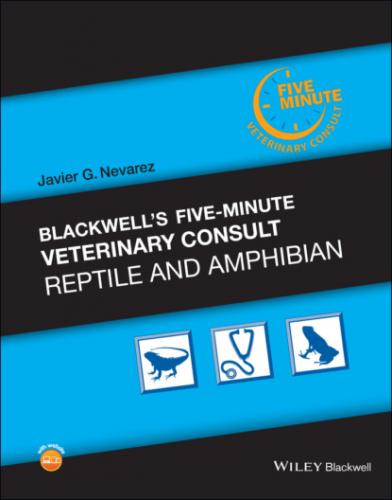Trauma leading to external or internal hemorrhage.
Maladaptation syndrome associated anemia—reported in stressed reptiles, associated with captivity or trapping of wild reptiles.
Hemoparasites
Malnutrition
Toxicity
Weakness and prostration due to metabolic bone disease, pregnancy, or infectious disease.
DIAGNOSTICS
Blood sampling is essential for diagnosis and monitoring of anemic reptiles.
Patient’s size, condition, and venous access must all be considered.
Venipuncture sites with minimal lymphatic contamination are preferred, to obtain a more representative sample of the peripheral blood.
In chelonians, the jugular vein is the site with the least amount of lymphatic contamination.
Alternatively, the brachial plexus and coccygeal veins can be sampled.
The subcarapacial sinus tends to have the largest amount of lymphatic contamination.
In critically ill, possibly anemic, reptiles, aim to collect a blood volume of no more than 0.5% of the body weight (0.5 ml/100 g body weight) so as to not exacerbate the anemic condition.
EDTA can cause hemolysis and artifacts in most chelonian, so lithium heparin is the preferred anticoagulant.
Physical Exam
Mucous membranes and general pallor—compared with mammals, reptiles’ mucous membranes are lighter in color but should still appear pink.
One exception is the family Chelydridae, which normally have rather pale mucous membranes.
Examination of the ocular conjunctiva and even the iris color in American box turtles (Terrapene sp.) has also been reported, associating the pale iris with low hematocrit and possible anemia.
Hematology
Although there is limited ability to assess all the same hematologic parameters as in mammals, some basic guidelines can be found for certain values.
Hematocrit/PCV
Normal values range from 20 to 45. Values below 20 suggest anemia in most cases.
A blood transfusion should be considered in animals with values below 10, although there is little research in reptilian blood transfusions.
Seasonal variations in this parameter should also be considered before making clinical decisions.
A low hematocrit with an increased polychromasia index is a normal physiologic change during brumation, but pathologic during the active season.
Hemoglobin
Normal values are 6–10 g/dl according to the species.
Lower values should suggest anemia. MCHC is calculated according to the hematocrit and hemoglobin, like MCH; these parameters show variation in case of anemia.
Individual variations should also be considered, as reptiles have different types of hemoglobin, which may influence the expression of clinical signs.
Polychromasia and Erythroblasts
An increased polychromasia and erythroblasts in general suggests an increased need for erythrocytes in peripheral blood and can be interpreted as evidence of a regenerative anemia.
Occasionally, a high number of erythroblasts may be found in the micro‐hematocrit tube, forming an intermediate layer between the buffy coat and the red blood concentrate.
This activity is usually accompanied by the presence of erythrocyte precursors in peripheral blood (erythroblasts, occasionally polychromatophils).
Hemoparasites may also lead to increased numbers of erythroblasts and polychromasia.
Polychromasia may also occur in the absence of anemia as has been reported in shedding reptiles.
Erythrocytic Mitoses
When detected in peripheral blood as an anecdotal finding, it is not a manifestation of anemia.
Anemia should only be considered when mitoses appear in erythrocytes together with the presence of abundant erythroblasts and other markers described, such as altered hematocrit and irregular erythrocytic nucleus.
Erythrocyte Counts
Total erythrocyte counts are lower than in mammals and birds.
Erythrocytes in chelonians are larger compared with other reptiles; they tend to have counts below 500,000/μl.
Fecal Occult3 Blood Test and Urinalysis
May allow for the detection of small amounts of blood in an animal’s urine or feces.
Fecal occult test may return false positives in carnivorous species.
PATHOLOGICAL FINDINGS
Pathologic findings will be specific to the underlying cause of anemia.
APPROPRIATE HEALTH CARE
Anemia is often a chronic presentation in most reptiles.
A slower metabolism and physiologic adaptation mechanisms allow reptiles to compensate better than birds or mammals.
Treatment is often not needed on an emergency basis, but is rather focused on addressing the underlying diseases and providing supportive therapy.
NUTRITIONAL SUPPORT
Proper nutrition is key for the prevention and treatment of anemia.
The diet should be as varied as possible and adapted to each species.
Diet should be balanced and contain natural sources of vitamin B12 and iron.
Nutritional support via gavage feeding should be implemented in very ill and/or anorectic animals.
CLIENT EDUCATION/HUSBANDRY RECOMMENDATIONS
It is recommended to perform annual health evaluations of the animals at risk.
These evaluations should include blood tests and fecal exams.
Any treatments must be performed based on the results of the exams and the historical data for the collection.
These tests should also be done on newly acquired and quarantined animals.
A proper nutritional plan is also essential for good health.
